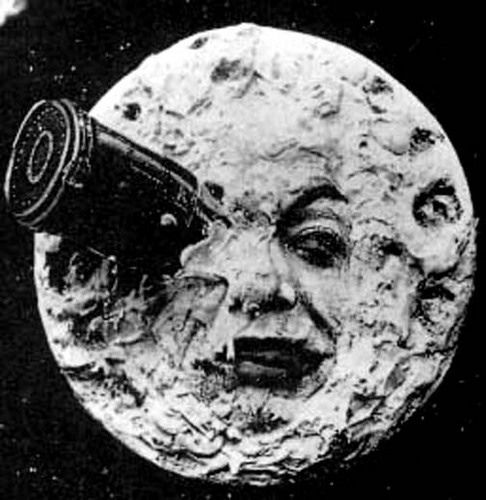
I was recently watching Wall Street: Money Never Sleeps, the sequel to the Oscar-winning 1987 financial cautionary tale. In the middle of a movie that had nothing to do with science, the lead character started explaining the financial investment potential of a national research facility loosely based on the ultra-exclusive National Ignition Facility in Livermore, CA (which ScriptPhD.com was fortunate to visit and profile recently). The film did such an impressive job of explaining the laser technology being used in real life to harness endless quantities of energy from a molecular fusion reaction that it could have easily been lifted from a physics textbook. Translating, explaining and visually presenting complex science on film is not an easy task. It got us to thinking about some of the greatest science and technology moments of all time in film.
In no particular order, with the help of our readers and fans, here are ScriptPhD.com’s choices for the Top 10 gamechangers of science and/or technology cinematic content that was either revolutionary for its time, was smartly conceived and cinematically executed, or has bared relevance to later research advances.
Gattaca
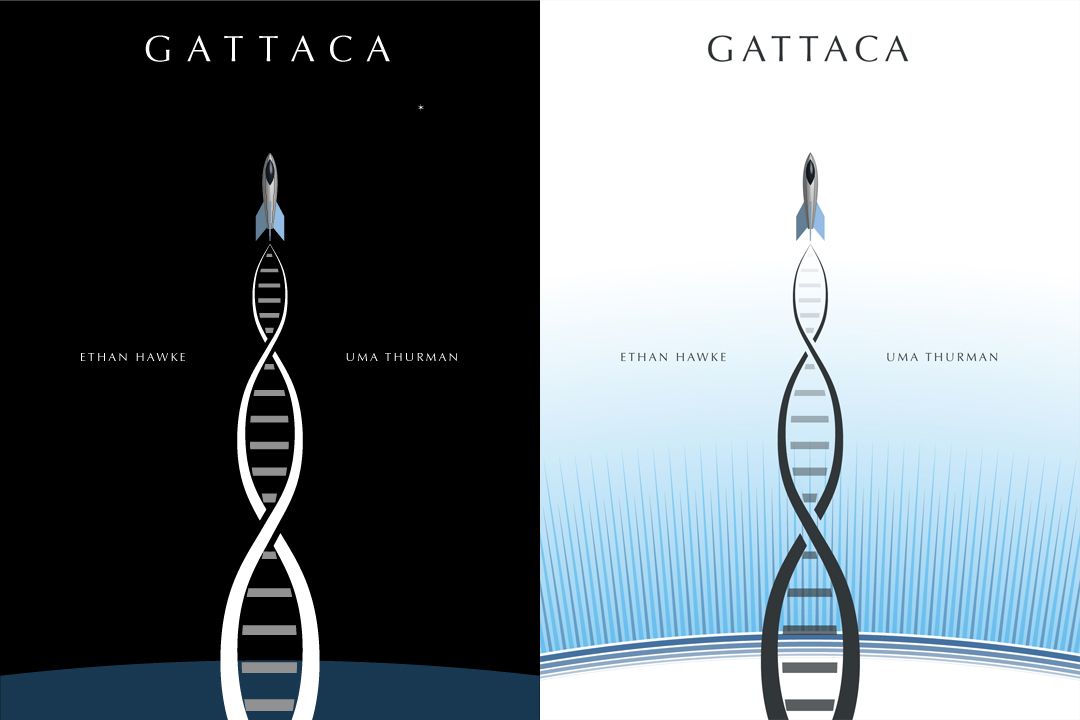
A trend-setter in genomics and bioinformatics, long before they were scientific staples, 1997 sci-fi masterpiece Gattaca has some of the most thoughtful, smart, introspective science of any film. To realize his life-long dream of space travel, genetically inferior Vincent Freeman (Ethan Hawke) assumes the DNA identity of Jerome Morrow (Jude Law), but becomes a suspect in the murder of the space program director. Not only is this the first (and only) movie to have a clever title composed solely of DNA sequence letters (G, A, T and C are the nucleotide bases that make up DNA), it was declared by molecular biologist Lee M. Silver as “a film that all geneticists should see if for no other reason than to understand the perception of our trade held by so many of the public-at-large.” In 1997, we were still 6 years away from the completion of the Human Genome Project. Post that feat of modern biotechnology, the ability to obtain ‘personal genomics’ disease profiles has led bioethicists to question who is to be entrusted with interpreting personal DNA information, and the United States Congress to pass the Genetic Information Non-Discrimination Act. Could we find ourselves in a world that judges the genetically perfect as ‘valids’ and anyone with minor flaws (and what constitutes a flaw?) as ‘invalids’? The eugenic determinism in Gattaca certainly portrays an eerily realistic portrait of such a world.
Contact
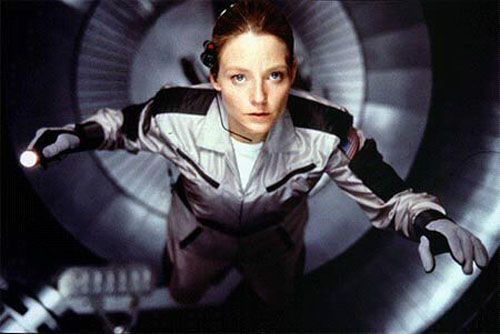
Voted on by several of our Facebook and Twitter fans (in complete agreement with us), Contact (based on the book by the most important astronomer of our time, Carl Sagan) is an astonishingly smart movie about the true meaning of human existence, explored through the first human contact with intelligent extraterrestrials. Rarely ambitious and quietly thoughtful science fiction for a big-budget movie, Contact is also one of the best explorations of the divide between science and religion. Bonus points for Jodie Foster’s eloquent and dedicated portrayal of what a real scientist is like.
A Beautiful Mind

It’s not often that cinema even touches mathematics or physics with depth and significance. It’s even rarer to see complex mathematics at the center of a poignant plot. 2001 Academy Award winning drama A Beautiful Mind was inherently not a film about mathematics, but rather one man’s quest to overcome a debilitating mental illness to achieve greatness. Nevertheless, the presentation of abstract mathematics, notably the Nash equilibrium that won John Nash the Nobel Prize in Economics in 1994, is not only difficult to do in film, but is done extraordinarily well by director Ron Howard. For anyone that has studied high-level math, or known a math professor, this film gives a picture-perfect portrayal, and possibly inspired a new generation of aspiring mathematicians.
2001: A Space Odyssey
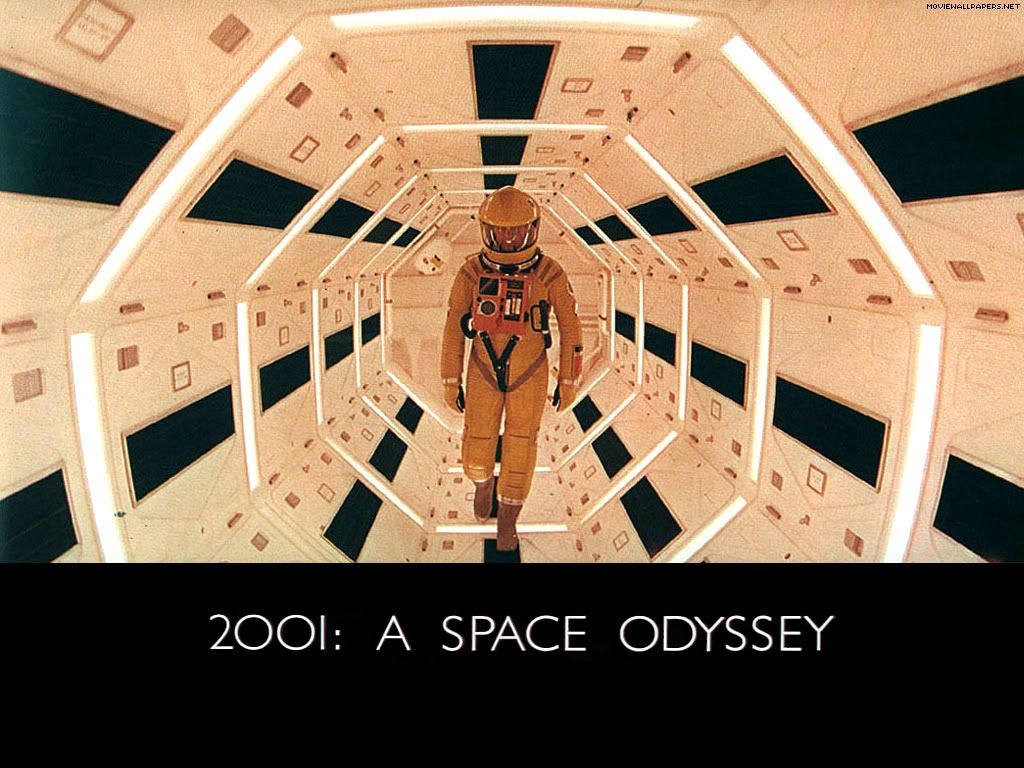
2001: A Space Odyssey is the greatest sci-fi film ever made. Period. Kubrik’s classic introduces an ahead-of-its-time exploration of human evolution, artificial intelligence, technology, extraterrestrial life and the place of humanity in the greater context of the universe. Although definitively esoteric in its content, individual elements could be lifted straight from a science textbook. The portrayal of an ape learning to use a bone as a tool and weapon. Missions to explore outer space, including depictions of alien life, spacecraft and computers that are so realistic, they were built based on consultations with NASA and Carl Sagan. The Heuristic ALgorithmic computer (HAL) that runs the ship’s operations is depicted as possessing as much, if not more intelligence than human beings, an incredibly prescient feat for a film made in 1968.
The Day The Earth Stood Still
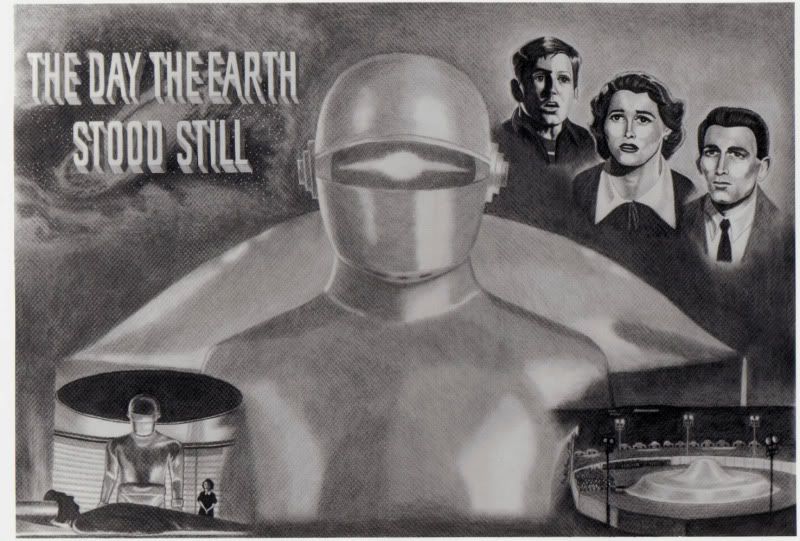
The Day the Earth Stood Still (we speak of the original, and not its insipid 2008 remake) is a seminal film in the development of the big-budget studio sci-fi epics. Given its age (the original came out in 1951), it still stands the test of time as a warning about the dangers of nuclear power. Well-made, sophisticated and not campy, TDTESS is one of the best cinematic emblems of the scientific anxieties and realities of the Cold War and nuclear era. It is usually a staple of Top Sci-Fi lists.
Jurassic Park
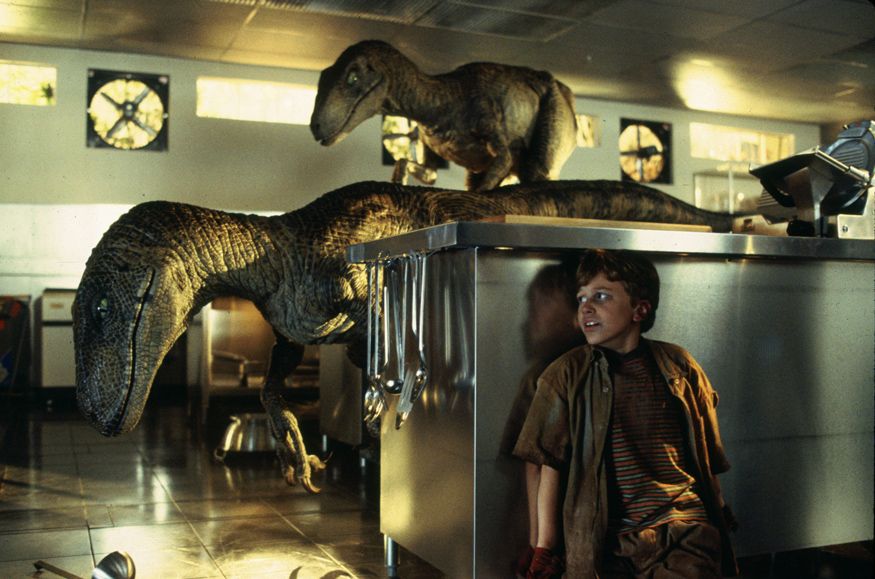
Jurassic Park, originally released in 1993, set one of the most important landmarks for modern science in film—the incorporation of DNA cloning as a significant plot element three full years BEFORE the birth of Dolly, the cloned sheep. Even more important than the fact that, although highly improbable, the science of Jurassic Park was plausible, is the idea that it was presented in an intelligent, casual and meaningful way, with the assumption (and expectation) that the audience would grasp the science well enough not to distract from the rest of the film. Furthermore, the basic plot of the film (and the book on which it was based) act as a cautionary tale about the dangers of unchecked scientific experimentation, and the havoc it can wreak when placed in the wrong hands. With the completion of the Human Genome Project in 2003, and the ability to sequence an organism’s genome in a day, bioethical questions about how personal genomics and the resurgent gene therapy are used are perfectly valid. Jurassic Park set a new standard for how modern science would be incorporated into movies.
Terminator 1 and Terminator 2
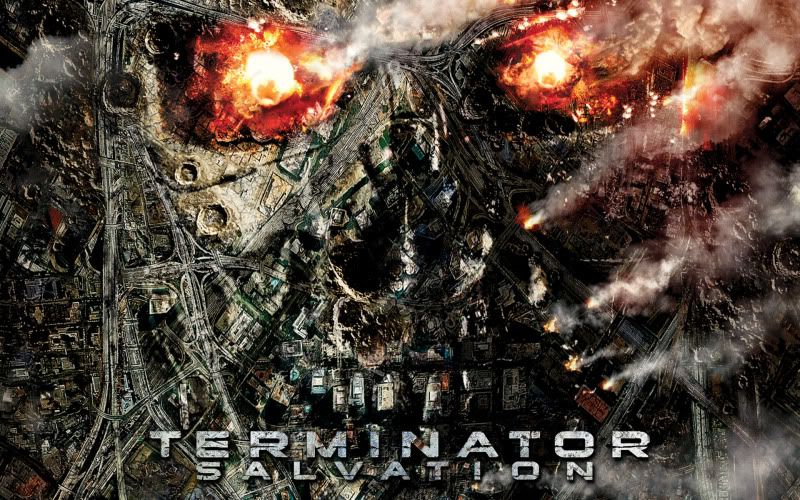
The Terminator?! Sounds campy, I know. We associate these adventure blockbuster films more with action, explosions and the rise of Arnold Schwarzenegger. Not game-changing science. Think again. The cyborg technology presented in these 1984/1991 action adventures was not only far ahead of its time scientifically, but smart, conceptual, and has really stood the test of time. Countless engineers and aspiring scientists must have been inspired by the artificially intelligent robots when the film first premiered. Today, with robotics technology enabling everything from roomba vacuum cleaners to automated science research, many engineers postulate that the day could even come that humanoid robots could someday fight our wars. Earlier this year, scientists at the German Aerospace Center even created the first ‘Terminator’-like super strong robot hand!
Apollo 13
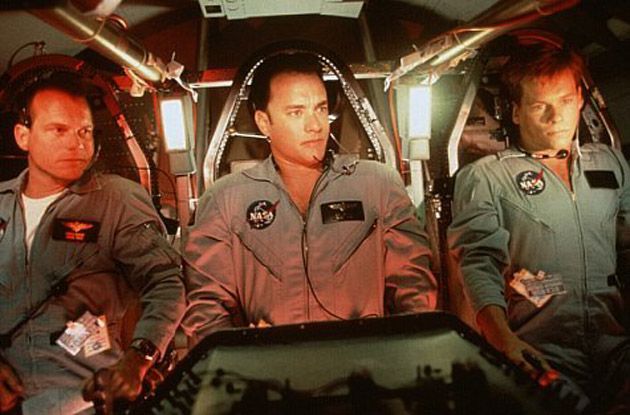
Space. The final frontier. At least in the heart of the movies. Far beyond the sci-fi genre, space travel, extraterrestrial life, and NASA missions remain a potent fascination in the cinematic world. For its feat as one of the most factually-correct space travel films ever made, with pinpoint portrayal of a monumentally significant event in the history of American science and technology, Apollo 13 enthusiastically lands on our list. Ron Howard’s almost-obsessive dedication to accuracy in detail included zero gravity flights for the actors (in addition to attending US Space Camp in Huntsville, AL), studying the mission control tapes, and an exact redesign of the layout of the Apollo spacecraft controls. Not only does the story inspire the spirit of adventure and innovation, it is 100% true.
The Andromeda Strain
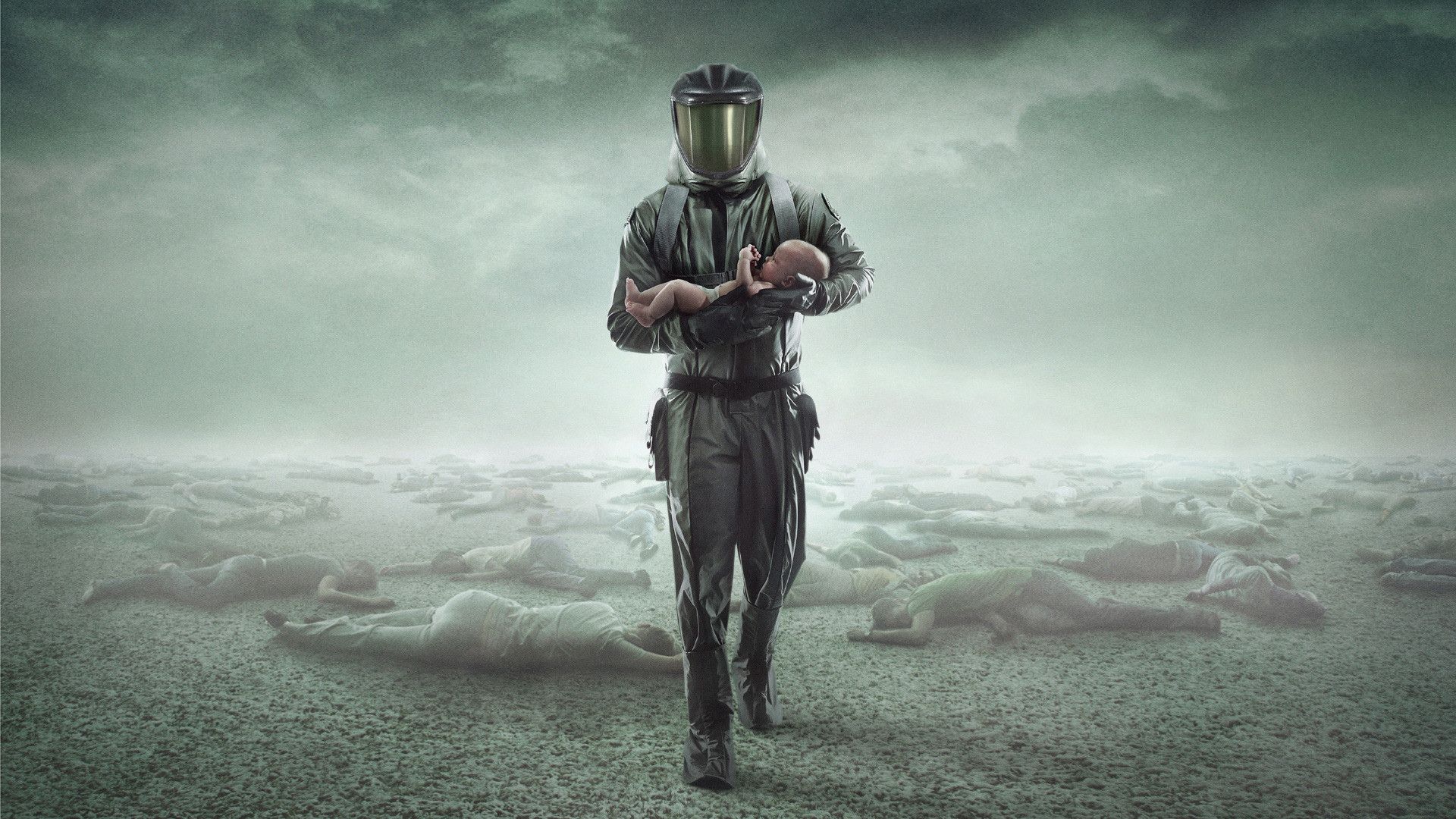
For a film made in 1971, The Andromeda Strain (based on Michael Crichton’s novel by the same name) is a remarkably modern and prescient movie that has had a lot of staying power. The first really significant bio thriller film made, Andromeda’s killer viruses, transmissibility, and global infections have become de rigeur in our modern world. In the film, a team of scientists investigate a deadly organism of extraterrestrial origin that causes rapid, deadly blood clotting—perhaps an unintentional foreboding of Ebola and other hemorrhagic viruses. While the idea of a terrifying pandemic or biological emergency has certainly been replicated in many films such as Outbreak and 28 Days Later, no film has done a better job of capturing not just the sheer terror of an unknown outbreak, but the science behind containment, including government organization, the team of scientists working in a Biosafety Level-4 laboratory, and the fact that the story doesn’t overshadow the focus on the research and lab work. (Incidentally, as far-fetched as Crichton’s plot seemed to be at the time, recent research has shown that Earthly microbes traveling with US astronauts gained strength and virulence in space!)
Moon
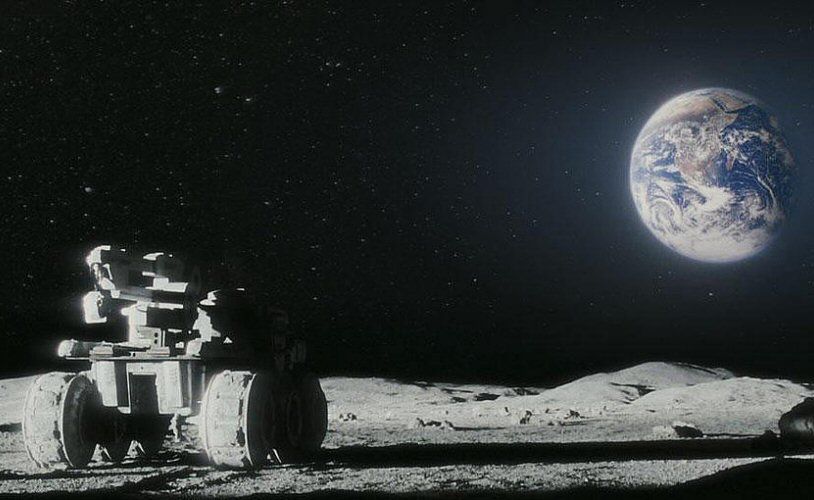
One of the most recent films to crack our Top 10 list, 2009’s debut gem from sci-fi director Duncan Jones failed to amass an audience commensurate to its brilliance and modern scientific relevance. A sweeping, gorgeous epic in the shadow of (and certainly inspirited by) 2001: A Space Odyssey, Moon (ScriptPhD.com review) tells the story of Astronaut Sam Bell (Sam Rockwell), who is at the tail-end of a three-year solo stint on the Moon, mining for Helium-3 resources to send back to an energy-depleted Earth. As the sole employee of his lunar station, Bell works alongside an intelligent computer named GERTY (Hal’s third generation cousin), but on the heels of his return to Earth, uncovers an insidious plot by the company he works for to keep him there forever. There are so many scientific and technology themes that made this an obvious choice for our list. Moon exploration and human colonization has been a hot topic for at least the last 15 years, with a recent discovery that the Moon may have as much water as the Earth sure to fuel possible NASA exploration and additional Moon missions. The ethical morass of a greedy company with technology capabilities cloning an employee is not only done brilliantly, but evokes a realistic, chilling possibility in our evolving scientific landscape. Finally, Sam’s relationship with GERTY (voiced by Kevin Spacey), who ultimately transcends his robotic limitations to exercise free will in helping Sam escape the pod, is especially poignant as technology becomes a more intimate part of human life and literally changes our neurological makeup.
~*ScriptPhD*~
*****************
ScriptPhD.com covers science and technology in entertainment, media and advertising. Hire our consulting company for creative content development.
Subscribe to free email notifications of new posts on our home page.
]]>
Greetings from sunny San Diego, everyone! ScriptPhD.com is in the absolute epicenter of sci-fi, comics and the illustrative arts: Comic-Con 2010. Armed with a press pass, our wonderful correspondent Brian Stempien of Lefty Films, and an industrial-sized vat of Purell, we are proud to bring you four-day coverage that spans the nexus of sci-fi, graphic arts, design, technology, film, television, and of course, the forum that started it all, comics. Day 1 coverage includes an array of panels covering the origins that drive an artist’s imagination, the future of cultural arts in a digital age, the future of space exploration with Iron Man’s Stark Industries as a model, good sci-fi, bad sci-fi, sci-fi that will change your life, and a conversation with two leading visionaries of the sci-fi genre, J.J. Abrams and Joss Whedon. ScriptPhD.com also got to chat with the stars and producers of our favorite forensics show, Dexter. Plus, we have a little secret teaser interview with a certain MythBusters star that we’ve been teasing for a good while now! As we always do at Comic-Con, we pick our Costume of the Day as part of our compete Day 1 coverage, under the “continue reading” cut.
The Spark of Imagination
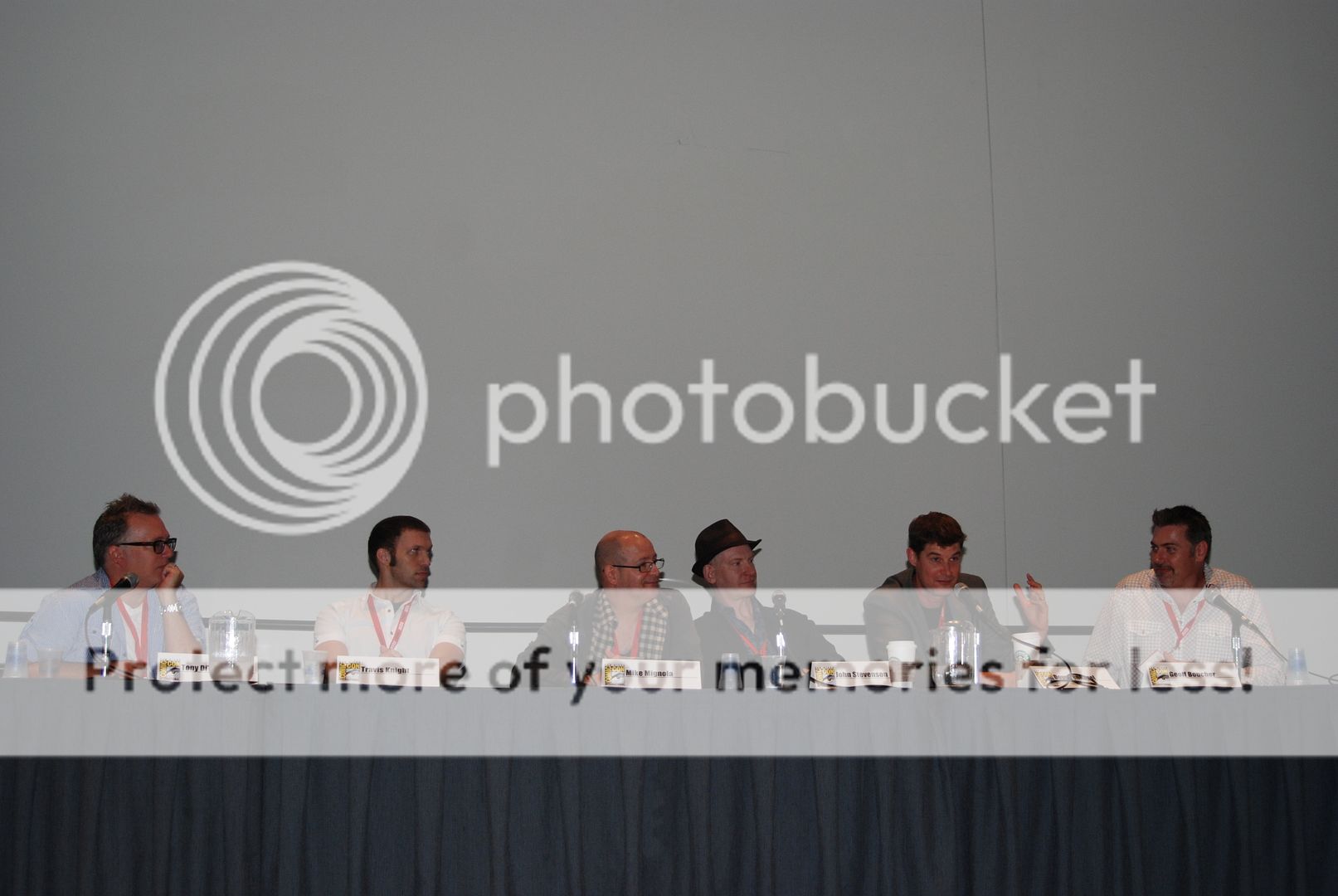
What better way to begin a four-day celebration of visual imagination than a panel of distinguished artists and designers discussing the “spark” that originates imagination, how to harness concepts and ideas, and how they feel imagination informs the creative process. The panel consisted of Tony DiTerlizzi (illustrator of The Spiderwick Chronicles), Travis Knight (lead animator of Disney’s Coraline), Hellboy creator/writer Mike Mignola, Kung Fu Panda director John Stevenson, Doug TenNapel (illustrator/writer of Earthworm Jim), and moderator Geoff Boucher of the LA Times blog The Hero Complex.
Let’s be honest, creative types are weird, weird people, me being one of them. Unequivocal unanimity was reached that this very oddness, which might alienate a person from the mainstay of society, was the very fuel that drove creativity and imagination. Tony DiTerlizzi recalled being a daydreaming doodler from elementary school onward, never listening to anything his teachers or figures of authority said to him, almost inhabiting his own world. (Sound familiar, creative readers?) Travis Knight concurred, adding that spontaneity, a side benefit of idiosyncrasy, is absolutely essential to the core of imagination. Artists never really grow up; they start out as hermits hiding in basements, grow into high school kids that get shoved into lockers, and end up playing with dolls as adults. But in a way, he added, it’s wonderful and liberating to live on the fringes of society, to see things in a way that adults have forgotten how to. Hellboy creator Mike Mignola expressed amazement and awe at people wiling to be brave enough to create things for the sake of creation, even if it will never see the light of day. “Let’s face it,” Knight sighed. “There’s something wrong with us.”
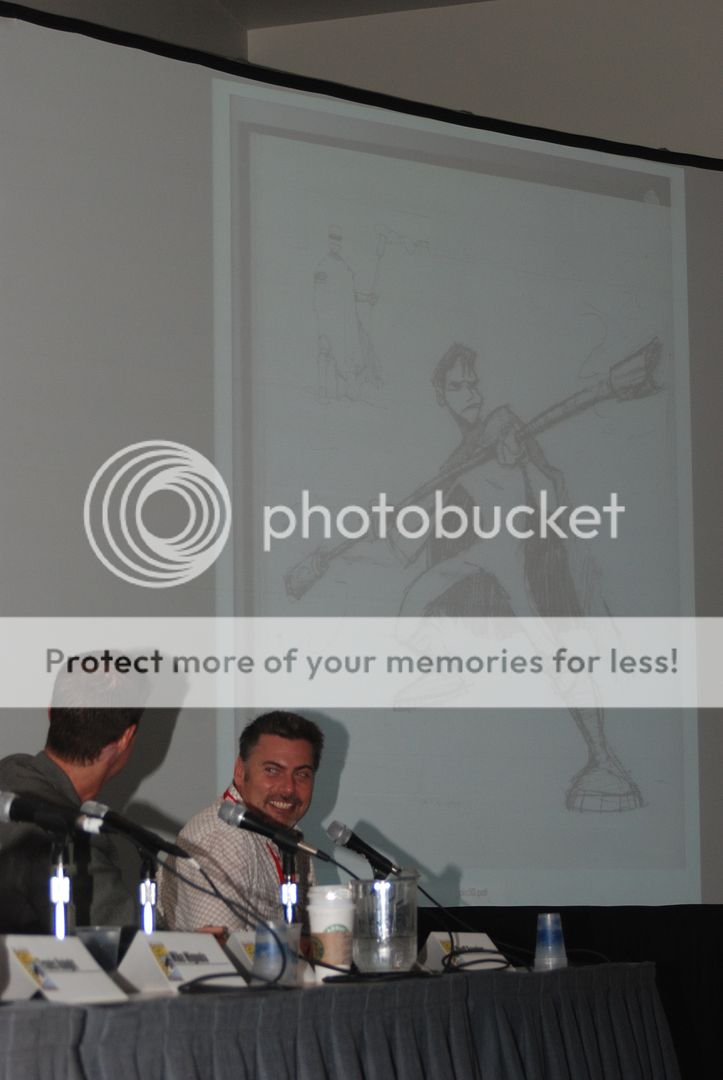
Recognizing and managing productive imagination when it happens were also a popular consensus among the group. It’s really easy to come up with stuff, maintains Doug TenNapel; it’s not really a special gift or ability and we all have it to some degree. The hard part is the execution in all forms of art. There are millions of ideas that will cross through our minds that will never see the light of day not because they’re not good, but because they aren’t viable. To develop those skills of managing and presenting ideas and putting them to use so one can make a living off of them, an artist has to become an “imagination editor” that parses out the ones that matter. Thank goodness Mignola refined that skill, or Hellboy never would have seen the light of day. He’d been drawing for years at conventions and other comics gatherings, usually on-demand for fans. After endless renditions of popular figures such as Batman, the fans wanted something more original, and Mignola sketched an early, rough inception of what would become Hellboy. Later, when asked to contribute a monster to a convention comic book, he recycled the character, drawing “Hellboy” on his belt to fill a blank spot on the page. Only later, when Mignola wanted to do his own comics, would the stories and three-dimensional world grow around that original central character.
DiTerlizzi also utilizes a character as a focal point for his stories. In order to care about a world, he reminded the audience, you must first care about the character that will inhabit it. How to come up with these characters and worlds? Research, imagination, and life experience! In researching a new character for Coraline, a model, Travis Knight watched YouTube videos of runway models. His biggest regret as he walked the halls of Comic-Con was seeing so many sequels, rehashes and remakes of 1980s TV shows and recycled concepts, and such a paucity of new thinking and bold ideas. This, Knight maintained, is the driving force for the future group of designers and illustrators.
Ultimately, making movies, TV shows, and even designing is inherently a collaborative process, one that the artist must accept if they want to derive the pinnacle of their imagination. John Stevenson ended the panel by emphasizing the three key concepts of successfully harnessing imagination: collaboration and sharing (all too lacking in the modern, fearful world of design and illustration), inspiring the people you’re working with as a leader, and thanking people and showing appreciation for those that have contributed to the betterment of a project.
Be inspired. Create. Let your imaginations soar!
Iron Man and Rocket Men: Is Stark Industries an Appropriate Model for Private-Industry Space Exploration?
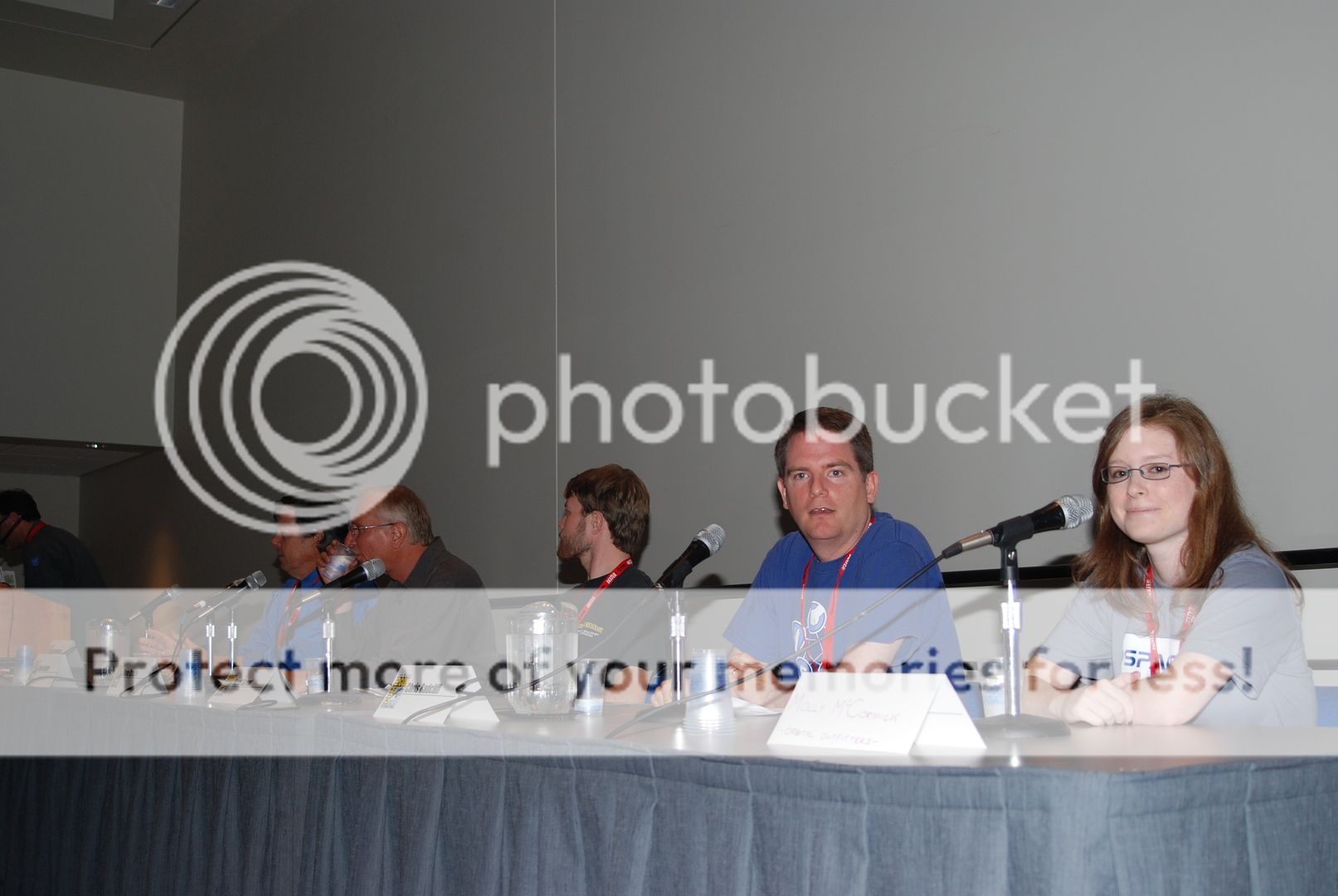
Iron Man was easily one of our favorite sci-fi movies from the past couple of years… and really, what was not to love? Geeky gadgets, innovative applications, and a true purview into the scientific discovery process (more on this later). More than a few mainstream publications have noted the strong ties the movie has to innovation (a couple of good ones can be found here and here). But a bigger tie-in can be argued between Tony Stark himself and the government contractors that constitute the vast majority of the space infrastructure, most notably NASA. So when we saw a Comic-Con panel devoted to exploring this very topic, we jumped at the chance to catch some of the action. Leading New Space entrepreneurs Mark Street (XCOR Aerospace) and John Hunter (Quicklaunch) joined Chris Radcliff (SD Space) and Dave Rankin (The Mars Society—San Diego chapter), with moderator Jeff Berkwits (former Amazing Stories editor) gathered to discuss what is right and wrong with NASA, and how the presence of small businesses can only help quicken the ‘space race.’
First and foremost, let’s define New Space. When we talk about Stark Industries, for example, we are talking about the most extreme example of the tech-based industry, representing the Lockheed Martins and Boeings (and to some degree NASAs) of the world—funded by the government, developing missiles, rockets, and even top-secret projects. New Space, and the small, innovative companies that are leading the forefront of its revolution, represent realistic opportunities for outer space exploration. They are Tony Stark working in his basement, on the cheap, on experiments that no one is seemingly interested in. In this case, it’s the idea of making space exploration available to ordinary people, not just military or astronauts.
The first half of the seminar consisted of a very heated argument about why more companies have not been able to take the lead in space exploration and where, exactly, NASA has stagnated so much. Mark Street pointed out the dichotomy between the entrenched business models of industry versus small companies, some of whom are already launching innovative space solutions and making a profit off of them. The established market, on the other hand, has a steady source of defined income, and no real incentive to decrease costs associated with space travel, which will take lots of investment and trial and error. Boeing isn’t building the next rocket, per se, but they are building airplanes thanks to already established rules and comfort zones. Smaller companies are ultimately able to address these problems thanks to risk-taking, failure, learning lessons, and innovating. John Hunter likened NASA to a modern March of Dimes, a philanthropic organization that was relevant back in the 60s, when it helped cure polio, but has since usurped 90% of donations for cost overhead and only 10% for actual causes that it supports. NASA’s budget of $18 billion consists of 70% “legacy” projects and 30% new innovation. What they need, he claimed, is new thinking, new risk taking. During the space war with Russia, “some of the dumbest guys I knew were looking for jobs at NASA,” Hunter maintains. “Because they knew they could study vortexes coming off of golf balls for the next twenty years.” Ouch.
To Dave Rankin, this was somewhat unfair. He invoked the sign at the X-Prize launch of Spaceship 1: “Spaceship 1: 1, NASA: 0”. To be sure, the X-Prize accomplishment was a worthy one, but NASA has been launching human beings to space stations for years, and they are still the only ones with a proven track record in the United States. Part of the problem is that because NASA is subject to political whim, it has no clear-cut focus with its identity (does it launch rockets, do basic research, innovate new technology, etc?). That lack of risk-taking at NASA is where you wind up with stagnation; it’s so big, with so many stake holders, that the sheer size lends itself to bureaucracy. The panel also brought up NASA’s two shining stars: the Jet Propulsion Laboratory in Pasadena, CA, and the Hubble Space Telescope. While JPL provides some of the world’s best robotics, such as the Mars Rover, the photography coming from outer space is simply amazing. “You can’t put a dollar value on some of what NASA does. It’s who we are as human beings, but you can’t make a profit off of it. As humans, we have to keep looking into what are the places of the universe and how did we come to be here,” said Chris Radcliffe. Quipped Rankin: “Let it not be said that government does not fund the arts.”
Take a look at a video of the first commercial launch into space:
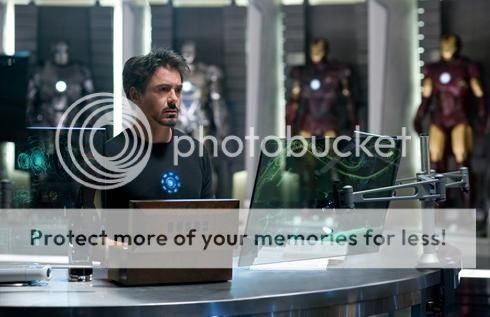
The inspiration for New Space exploration—for sticking Tony Stark into a basement—is that we need some more inspiration from space exploration than we are getting from traditional launches, and that will involve sending more people into space. Chris Radcliffe gave an example of a young engineer working at Hewlett-Packard in its early days who had the brilliant idea that computers could be more than technical devices; they could be personalized, streamlined, and made accessible to everyone. Hewlett-Packard didn’t agree, so he formed his own company and made that computer. The man? Steve Wozniak. The company? Apple. The computer? The Apple I. Like many of the companies comprising the New Space revolution, the design process in Iron Man is from top down, but the fun part is in the testing—you never quite get the process right the first time around.
Overall, the panel was very optimistic about the future of space travel and exploration, but emphasized the importance of spin-offs and small companies as a means to accomplish that. The biggest hurdles they will face is lowering prices of going to space, and overcoming the bad publicity of any first deaths that may come from the danger factor. Foreign competitors will have an even bigger role in driving our exploration. China will keep us on our toes, as they are very good at taking an idea, copying it and productionizing it. What will be the role of these companies in space exploration? Chris Radcliffe is pretty sure that space tourism will succeed, but that it will only comprise about 5% of the market. But it will be enough to drive producing vehicles and rockets and spacesuits and supplemental research off of things that will make money. The NASA CRuSR project, for example, takes existing suborbital platforms and doing science (in this case access to space for a reasonable cost) that they otherwise could not do on their own.
One of the more lighthearted moments, amidst a lot of PhD degree flaunting both from the panel and several people who asked questions, was a gentleman who prefaced his question by saying “I work in a coffee shop.” The reply from the panel: “You’re my hero!” While he respected space exploration as an ideal, he wondered whether the enormous cost of availing space to the average man might be better spent on pragmatic problems that can be solved right here and right now. Unanimously, the panel agreed that expanding human presence in space can only improve standards of living for everyone. If we wait until all our earthly problems are solved, they maintained, we’ll never do anything else.
Dave Rankin gave perhaps the best reason why New Space could be the future of exploration. “Space exploration is a forum for humanity: when we find a new space, we try to fill it.” We think Tony Stark would agree.
State of the Geek Report
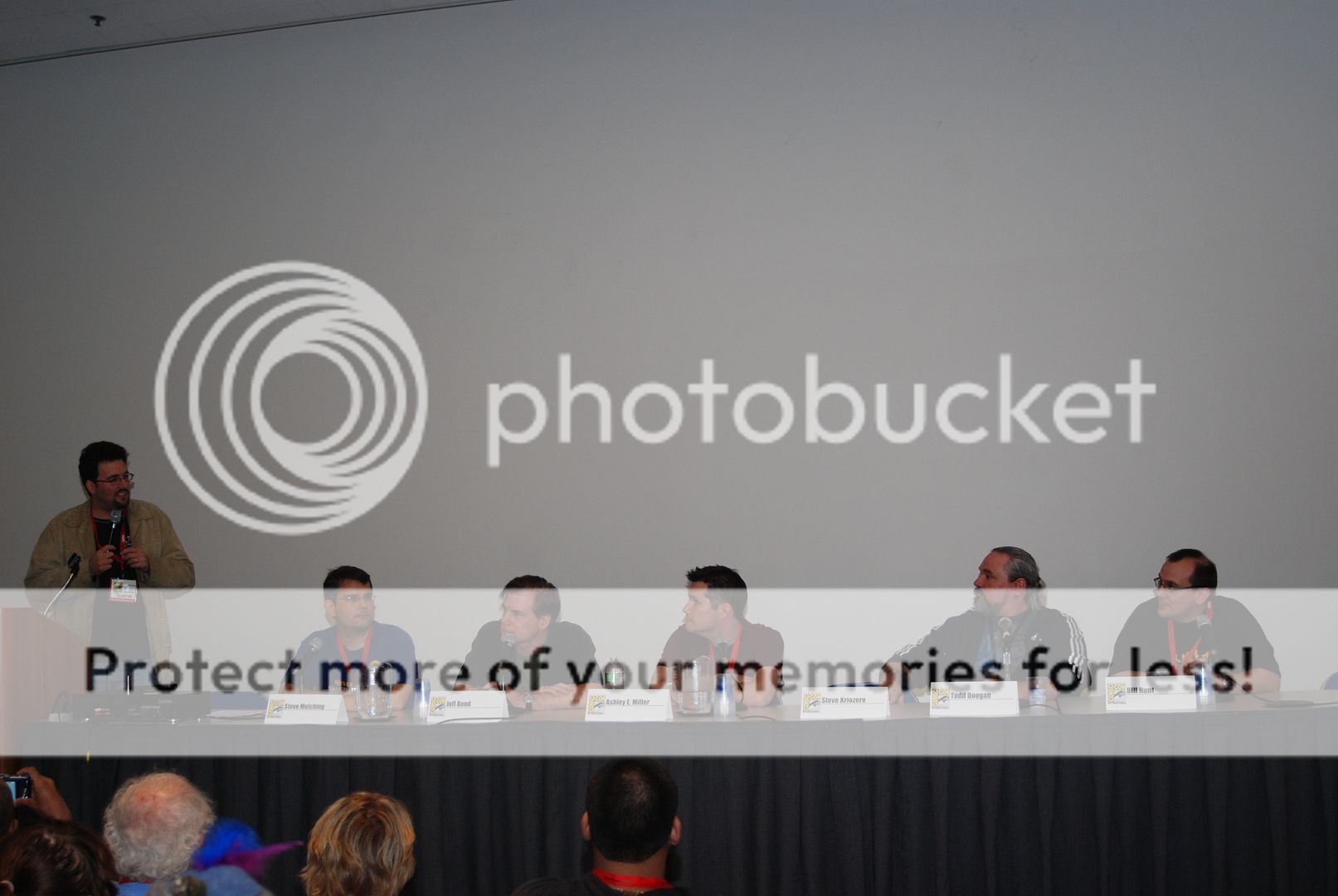
From the more substantial programming of earlier in the day, we decided to devote the rest of Day 1 of Comic-Con to exploring our inner geek, with two panels looking at the best (and worst) of sci-fi in current entertainment. We started off with the “State of the Geek Report” panel, an exploration of the state of science fiction, fantasy, and horror in television and film today, and what the success of Avatar means for the future of movies. Steve Melching (The Clone Wars), Ashley E. Miller (Thor, X-Men: First Class), Steve Kriozere (Elvis Van Helsing), and Bill Hung and Todd Doogan of Digital Bits joined Geek Monthly editor and moderator Jeff Bond in discussing all things geeky in modern sci-fi.
Overall, the panel agreed that 2010 (largely carrying over from 2009) was one of the strongest years on record for sci-fi content. In some ways, we are at a peak of great sci-fi presence in pop culture and visual mediums, echoing 1982, considered by some to be the greatest year for sci-fi movies ever (Android, Blade Runner, ET, Forbidden World, The Wrath of Khan, Tron, etc). However, Bill Hunt maintained that Hollywood continues to try too hard to make every sci-fi film an “event,” and is getting excited for releases, but for all the wrong reasons. Not every film can be a blockbuster. In the past year, of the sci-fi films that got high marks from Jeff Bond, many were produced on extremely low budgets, including Moon, District 9, and the indie sci-fi film Yesterday Was a Lie. He also gave high marks to Star Trek and Avatar, which is where the panel took a big of a detour.
While Bond felt that the traditional, universal storytelling and high craft of Avatar made it a great success, Ashley Miller felt otherwise. Every dollar spent on the film was for aesthetics, and indeed, frame by frame, it is a beautiful film, including changing our expectations of what a 3D film should look like. However, as a complete work of art, it was shockingly lacking. To that, the panel brought up the point that what Cameron did with Avatar was harness 3D technology effectively, but the idea that every film now needs to be in 3D is ridiculous. Of recent releases, the brilliant Inception manages to be a challenging, engaging movie without the use of 3D technology.
Visionaries such as Christopher Nolan and James Cameron are given a lot of autonomy in their filmmaking—they are auteurists whose vision leads to the ultimate conclusion. Does sci-fi filmmaking lack for more Nolans and Camerons of the world? Autonomy, the panel decided, is earned. And not every director walking around is a Chris Nolan or James Cameron. Cameron made the original Terminator, which many feel is one of the greatest sci-fi movies of all time, on a shoestring budget. And Nolan used every penny of Inception’s mega-budget wisely. District 9 (which ScriptPhD.com loved) was shot in South Africa, with a native cast, on a very small budget. Moon, which we also liked, did all their special effects on model scale, with digital enhancements.
Ultimately, sci-fi is hurting most from studios turning everything into a “brand”: they are minimizing risk with constant remakes, but will ultimately have to swallow their tails and go towards original content at the risk of running out of material to remake. Sci-fi on television, which does not wallow in such an ignominious fate, is suffering from an embarrassment of riches. Highlights included Caprica, which invented an original, immersive futuristic world, and Stargate, which indulges in the essence of science fiction; to get the scope of wonder about other planets and life forms in the universe. (We will be joining cast and crew from both of these shows on Day 2 of Comic-Con!)
Abusing the Sci of Sci-Fi
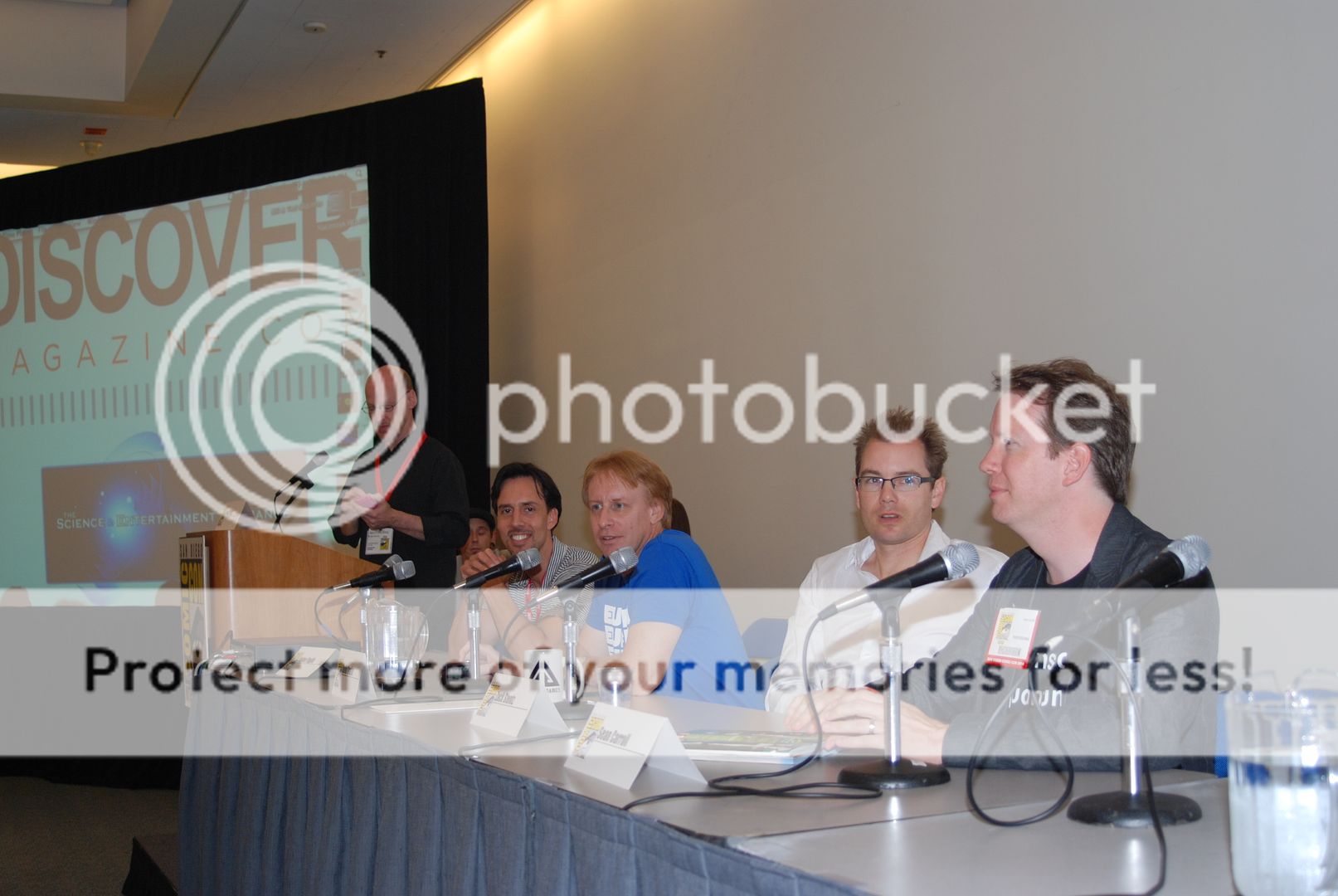
From a discussion of the best of sci-fi, we went to what always ends up being one of our favorite Comic-Con panels, Discovery Magazine and Science and Entertainment Exchange’s “Science of Science Fiction.” Hosted by the hilarious, delightful and brilliant physicist Phil Plait (of the Bad Astronomoy blog), the panel was an equal mix of writers and scientists: Eureka creator/head writer Jaime Paglia, Battlestar Galactica and Eureka science advisor/physicist Kevin Grazier, Fringe writer Zack Stentz, and physicist/author Sean M. Carroll.
In perhaps one of the smartest ways we’ve seen yet at Comic-Con, the panel collectively provided examples of “good” and “bad” science on television and in film through clips. We’ll provide you with some of the highlights. Plait started the procession by admitting that he himself became interested in astronomy by watching Star Trek and Space:1999, and maintains that there is a lot of inspiring science in television and film, despite the bad. That said, his “worst” clip was from Armageddon, a scene Plait maintains is possibly the worst science film clip ever—Bruce Willis is supposedly on an asteroid and yet it’s raining! “Jerry Bruckheimer, you’re not in the audience are you?” He asked. “Armageddon. Worrrrrrrrrrst movie ever made!”
Paglia, bravely, picked scenes from Eureka as both his “good” and “bad” clips. The bad was a terrible attempt at an episode where nanoids have started to replicate biological organisms, while the good was an episode where Eureka made its own version of the Hadron supercollider. Quipped Stentz: “I have lived in Eureka in Northern California. Let me telll you…not filled with geniuses!”
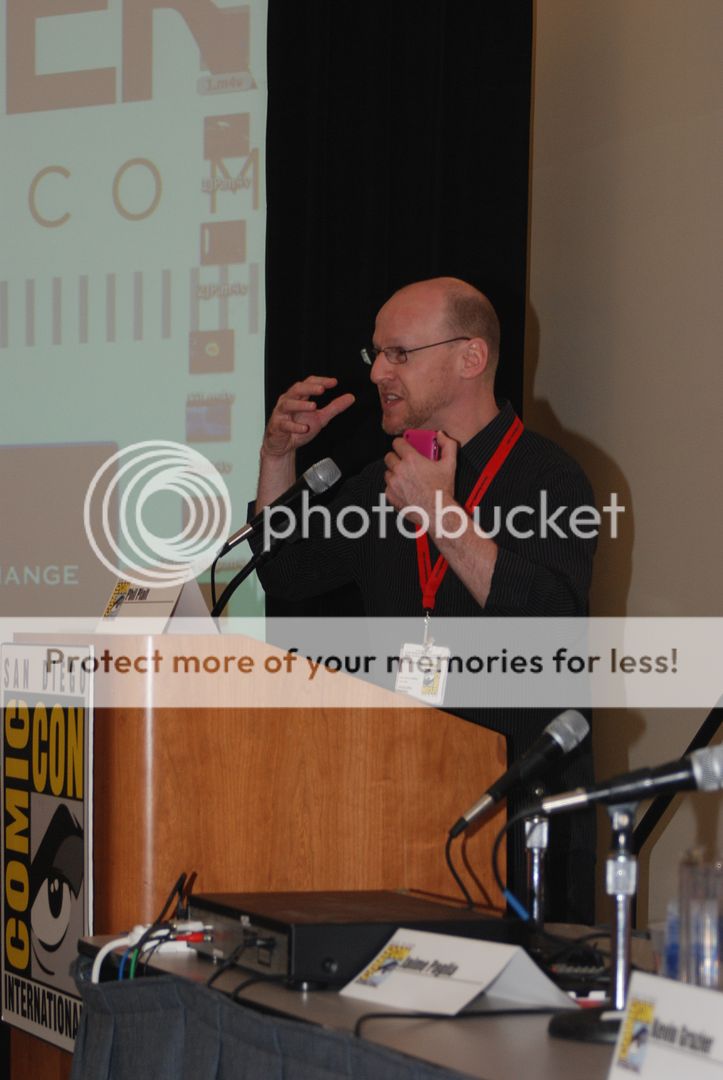
Grazier, agreeing with Plait that Armageddon is the worst science film ever made, maintains that it has lessons of both good and bad science. In a scene showing the hypothetical impact of the impending asteroid (complete with overdramatic voiceover: “It has happened before, it will happen again!”), the shock wave of the impact is shown traveling around the Earth, which would not happen, while secondary impacts, which would happen, are omitted. The film was overly dramatic where it didn’t need to be, and yet missed out on an opportunity to show really scary science that was accurate. “It’s the only film that ever lost me in the first 30 seconds,” said Grazier. That said, the scenes showing post-asteroid tsunamis and other ramifications are so perfect, they could be a computer simulation for an asteroid impact on Earth.
Stentz, in a bit of writer’s defense, pointed out a bad scene from Fringe where the science was purposely abused in the service of an otherwise good episode. He wanted to illustrate that sometimes, you have to break the rules in order to tell the story you want to tell. Here, the writers wrote a story line where Walter’s hippocampus was “stolen” to remove his memory. To retrieve it, the team suggests implanting the memories (via the brain pieces) in the brain of someone who could interpret them. “I’m not a neurologist, but I know enough about memory to know that it doesn’t work that way. We knew that when we wrote it. We wanted the drama of a theft from someone’s brain, and how do you use them. That’s why you heard the line, ‘In theory, you shouldn’t be able to do that.’”
Carroll, ever the ambitious physicist, provided a theory, as opposed to just clips, against the philosophical backdrop of issues raised by the demands of narrative versus scientific accuracy. Take a look at the following Big Bang Theory clip of Sheldon explaining Superman and gravity:
This is the right way to think about science versus storytelling. A lot of writers are afraid of scientists because, frankly, we’re ANNOYING. We act as copy editors: “You can’t do this. You can’t do that.” But scientists are also good at telling you the consequences of existing laws, even if it ruins the romance of Superman. Science can make a story better by following this formula for conflict. On the opposite side of the spectrum, you have the mysterious “Red Matter” from this past year’s Star Trek remake. No one knew what the stuff was, how it worked, just that it was a ball, it was bad, and you had to use a hypodermic needle to handle it. It’s far more interesting if you know the rules, can explain the science, and integrate that smartly into the storyline.
A lot of times, people think science fiction means anything can happen at any time, and that’s actually science magic. The rules don’t have to be scientific rules, but good drama comes out of limitations (scientific or otherwise), characters not being able to do something and coming up with another solution for it. As a working writer in TV/film, you want people wanting clarity on one side, but on the other had, you don’t want people to feel stupid and you can’t bore them. You can introduce science and technology in a way that heightens the excitement rather than taking them back to science class. ER used a writing trick to make this happen: one line of exposition, another line of exposition (medical jargon), then an emotional line telling you what happens. Ellen Page of the recent move Inception served this purpose as the audience member—what questions would they ask of the characters in the movie. To this degree, Carroll awarded Iron Man the award for best “science” movie of recent times, not for any specific science content, but because building the suit shows the true scientific method, and that’s how it’s really done in the lab!
Our intrepid correspondent Bryy Miller also went to two very exciting panels that covered a bit more mainstream pop culture. Here is what he had to report:
Tripwire Magazine
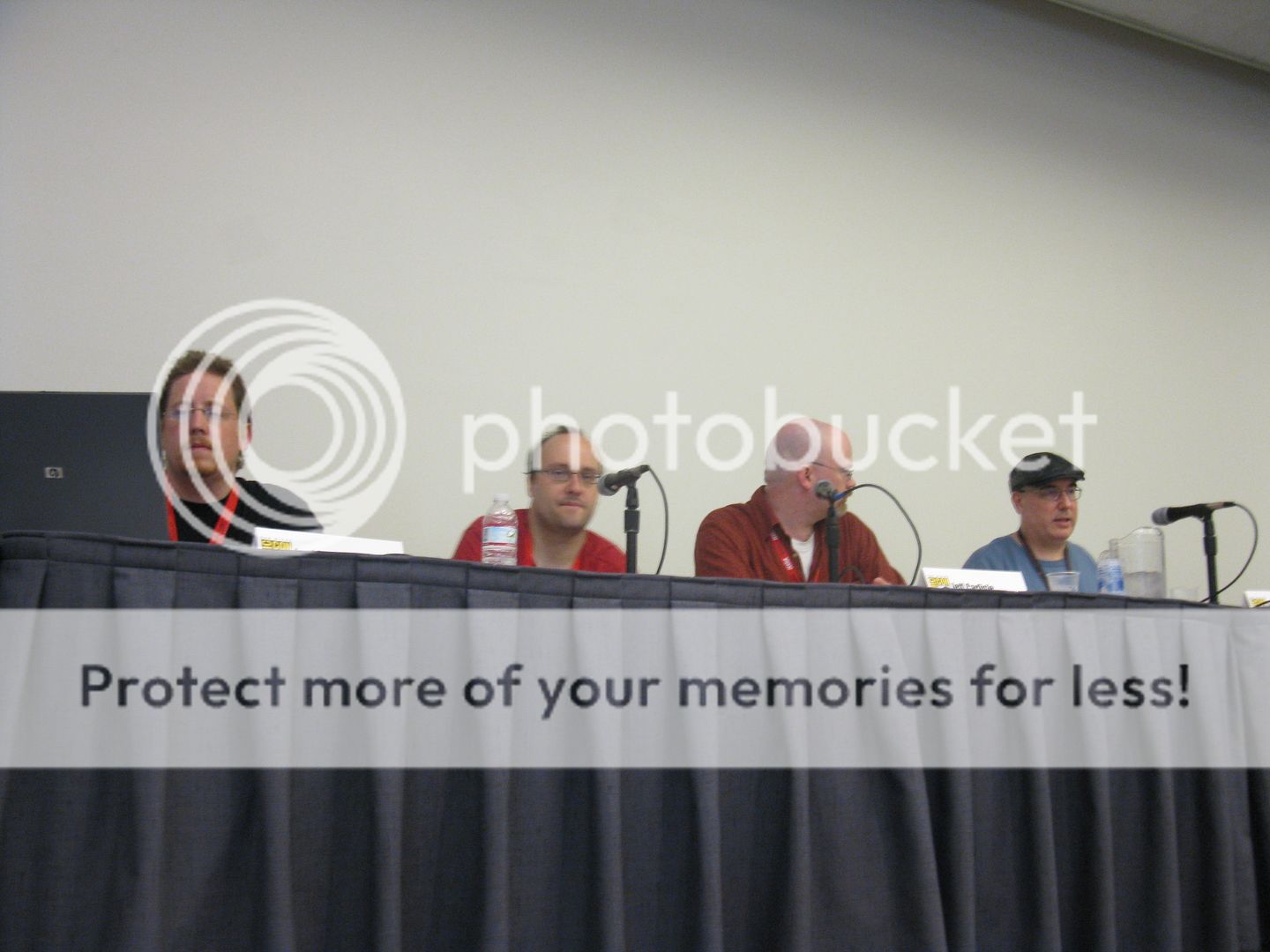
I had a theater class in high school, and we used to say that it was the most “un-schooly” class ever. It existed within the confines of the high school, but did not feel as constricting or regulated. Sitting in with the guys from Tripwire Magazine, a joint UK-American geek culture print, evoked the same feeling. It understood that the Con existed, but the speakers (Editor-in-Chief Joel Meadows, U.S. Editor Andy Grossberg, and Staff Writer Jeff Carlisle, and guest speaker Rich Johnston [editor of Bleeding Cool News]) were so aloof and full of intelligent confidence that everything seemed to fade away. They made the audience feel like they were a part of Tripwire – Joel even mocked the obscurity of their little magazine being at Comic-Con by proclaiming “welcome to the Tron panel, everyone!”
Their little magazine, starting as nothing more than fan scribblings in 1992, slowly gained notoriety over the years until they halted for a bit in 2003 due to their current publisher financially screwing them over. They got back on the horse in 2007, and since then, have gone on to catch things in geek culture such as the coveted first set visit for the superhero film, Kick-Ass. This proved to come back to teach them a further lesson in industry magazine politics, as the article was released a full year before it was assumed that it would. Tripwire covers everything in geek culture except music and gaming, and now they have set their eyes on new media such as webcomics and webserials.
“Anyone can get in, but how do you get people’s attention?” Grossberg mused, before giving Felicia Day’s The Guild as an example. A highly successful webseries about gaming, The Guild has a frothing following that has attained such levels due to catering to an audience that already surfs the web daily, and that would most likely consist of gamers. But Grossberg has another theory, and it is much more pernicious in nature as well as much harder to digest. “You know what they expect [newspaper] editors to do?” Grossberg asks Meadows, talking about the changing roles of businessmen in the digital age. The Editor-in-Chief simply replies: “Everything”. Turning to us, Andy Grossgberg comes to the summary of the thought that he started with The Guild, and that is that old media is dying because nobody has an attention span. He then goes on to lay out all of the various people involved in the making of a print comic versus the one or ones involved in making a webcomic. Carlisle then speaks up with his input on if you want to make money as a comic creator in the age of new media, “do a webcomic … everything will be the same thing [as far as everything being digital].”
This all went over fairly well until they asked to see a show of hands concerning who knew what they were talking about. Apparently, I was the only hand that shot up. It seems that the digital divide is still there, which scared me, considering we just spent an hour talking about how fast the winds of change are blowing. The panel ended with a heated discussion over which comic adaptation is the most “meta” because after all, this is Comic-Con.
EW Visionaries: J.J. Abrams and Joss Whedon
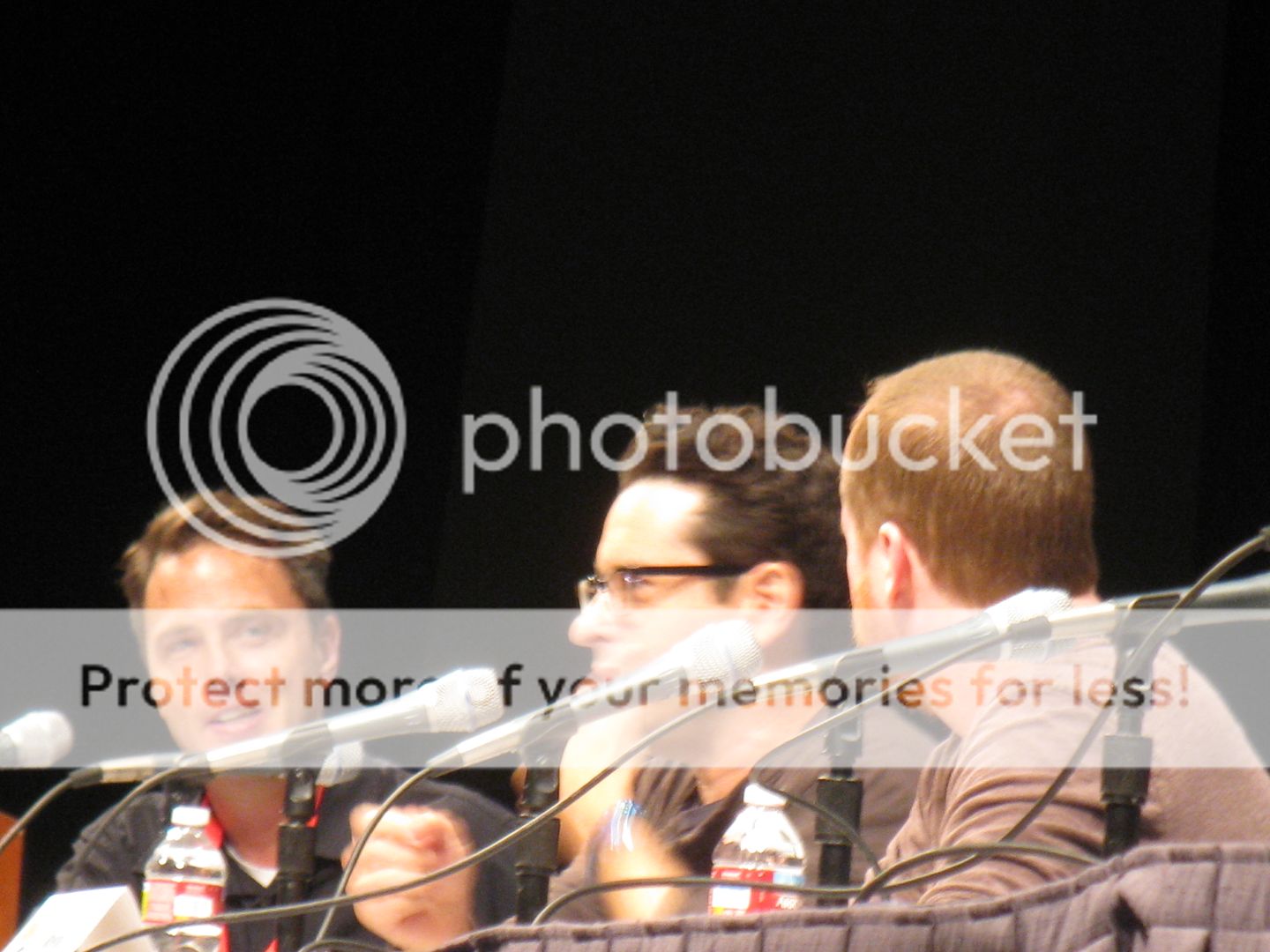
Both J.J. Abrams (Alias, co-creator of Lost, What About Brian?, Cloverfield) and Joss Whedon (Buffy the Vampire Slayer, Firefly) are rock stars in the world of television genre writing. So it would go without saying that their combined might upon one singular panel would cause another big bang, or the birth of a unicorn, or at least get a boatload of fans churned up to Twilight-levels of excitement. That was the feeling in the enormous venue Hall H: that the world would halt for a brief hour while these two decided how to continue shaping it. Well, unfortunately, no unicorns were birthed. Fortunately, it was still a good time. Instead of the melding of ideas and thoughts, it was more of a dinner between two famous film people that enjoyed answering questions specifically asked of or about them. They would occasionally reference that the other dinner guest was eating at the sane table, but other than that, it could have been a Joss Whedon panel followed by a J.J. Abrams panel.
The moderator opened it up with a hum-dinger, asking Whedon if he was indeed officially announcing that he would be directing Marvel’s superhero team flick, The Avengers. At first, Whedon said that there was no official word yet, but then he followed that by saying the official word. This, needless to say, got a gigantic response from the unfathomably-huge, wide, and deep crowd. Abrams had nothing new, but gave a movie story none-the-less: when he was a small child, one of the crew members from The Exorcist mailed him an actual tongue from the movie. It was in no way related to what Whedon had just announced, nor was it a movie announcement, but it somehow felt like it was contributing to the larger narration of the panel. Abrams was then asked about his infamous draft of Superman Returns, in which Krypton does not explode and Lex Luthor is an alien. “It was not well received” Abrams sheepishly said, referencing the fan-storm that had swept the internet mere hours after it was put online. Abrams followed that up with talking about how he managed to team up with Steven Spielberg for Super 8, his mysterious monster move that, even though a teaser has been released, is not yet filming. “I was told that Steven Spielberg made movies when he was my age,” Abrams began “so they asked me and my friend to clean up some of his old movies…. They have in-house studios for that sort of thing, and they paid us $300, and I knew why they did not do that”. He added that the film would not be in 3D.
Whedon stated that he was fine with 3D, as long as it was done well. He was also fine with 3D as long as it was not in his upcoming horror movie, Cabin in the Woods – which it is. “I love it, it puts you in the space… [but] the movie has to work in 2D” he said. Abrams revealed that he was still on the fence regarding the issue, “everything gets dim… it seems less.”
Before a rather banal question and answer session filled with every Whedon and Abrams fanboy imaginable, Whedon took the time to talk about Dr. Horrible 2, the much talked about sequel to Dr. Horrible’s Sing Along Blog. When discussing the project, which would continue the story set forth in his webseries created during the Writer’s Strike (and has since become the second Whedon-written musical to become a staple of Comic-Con). “I missed my window,” Whedon said, on the topic of digital media “I was waiting for people to show up to the party.”
Even though the Q&A session was quite lame, and I do not like Abrams, something spectacular happened at the very end of the panel. A young lady asked if criticism is ever okay for writers, since her brother recently asked for some and then shut himself off from her when he received it. This clearly made Abrams livid, as he asked for the man’s phone number. His intentions were clear. That’s when I finally found something I liked about Abrams. I connected with him as a writer and as a human being. In the big picture, that’s what these panels are for. Not to showcase new projects or to grandstand, but to connect.
From the Press Room: DEXTER
ScriptPhD.com was extremely fortunate to join producers and stars of SHOWTIME hit Dexter on their way to their Comic-Con panel. Here’s some dirt that we picked up! (We promise to catch up with Michael C. Hall, who was literally rushed out before our very eyes, back in Los Angeles in a separate post devoted entirely to Dexter.)
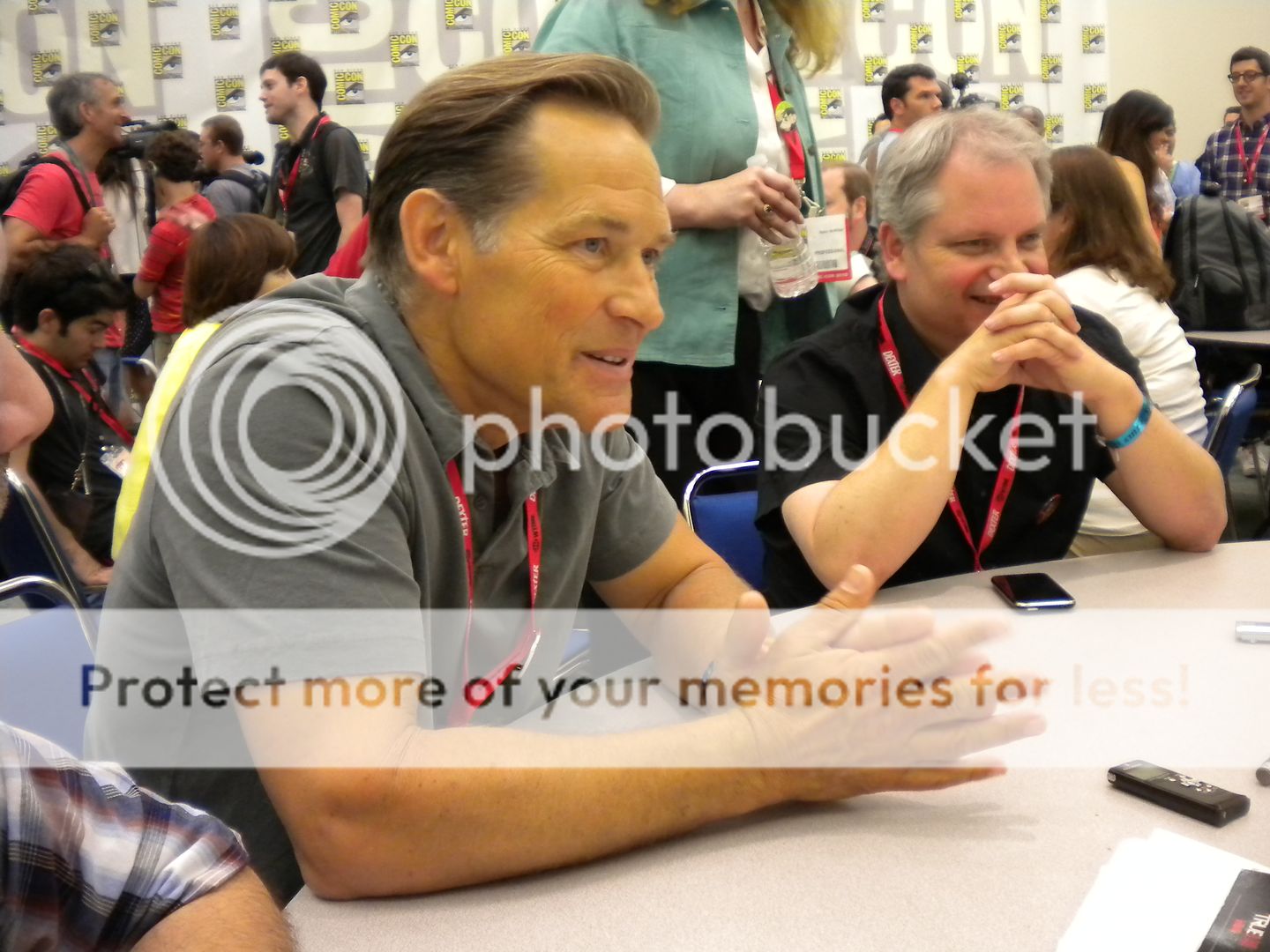
The production staff at Dexter is getting a shake-up. This year, they’ve added several new producers, including Tony Goldwin (pictured), who visited Comic-Con along with the old guard to give us some insight into things we can expect from the show this season. Part of the strategy of the “new energy” is a shake-up of the show itself. The producers wanted to avoid the “one season, one adversary” formula and recalibrate the show’s content while delivering the same pleasing product to the audience. So expect a lot of differences this year with what Dexter deals with and whom he battles with (if at all).
Unlike a lot of other shows adopting the popular meme of “skipping time” for resolution, Dexter will pick up right where we left off to get all the blowback over Rita’s death. And what a lot of blowback there is! The newest change, producers tell us, is that Dexter is feeling a new emotion for the first time… guilt. It’s something he’s never felt before and quite new for him. Much of this is because he was so hopeful as the season ended that things might actually be heading towards a positive change, that he might get rid of the dark passenger, he was looking forward to a honeymoon with Rita, only to come home and find her dead and his son in a pool of blood. Dealing with that will be very difficult for him, but the producers couldn’t tease us with more. On top of all of this, people are starting to figure his tendencies out, which adds yet another layer of complexity.
ScriptPhD.com asked about the forensics of the show and how they’re keeping it fresh. Said Producer Sara Colleton: “Well, we have an expert who works with us, and they’re the tech person. You just keep up to date with what is used by police. What we don’t do is CSI-style, flashy, make-believe forensics. I don’t know how to go in your nose and down your throat and find a bullet and say “Here it is!” We really try to play by the rules in terms of how long a DNA test takes, what the limitations of top forensics are. We want those things to be real, because the conceit of the show is so unreal, that we want everything else to feel real.”
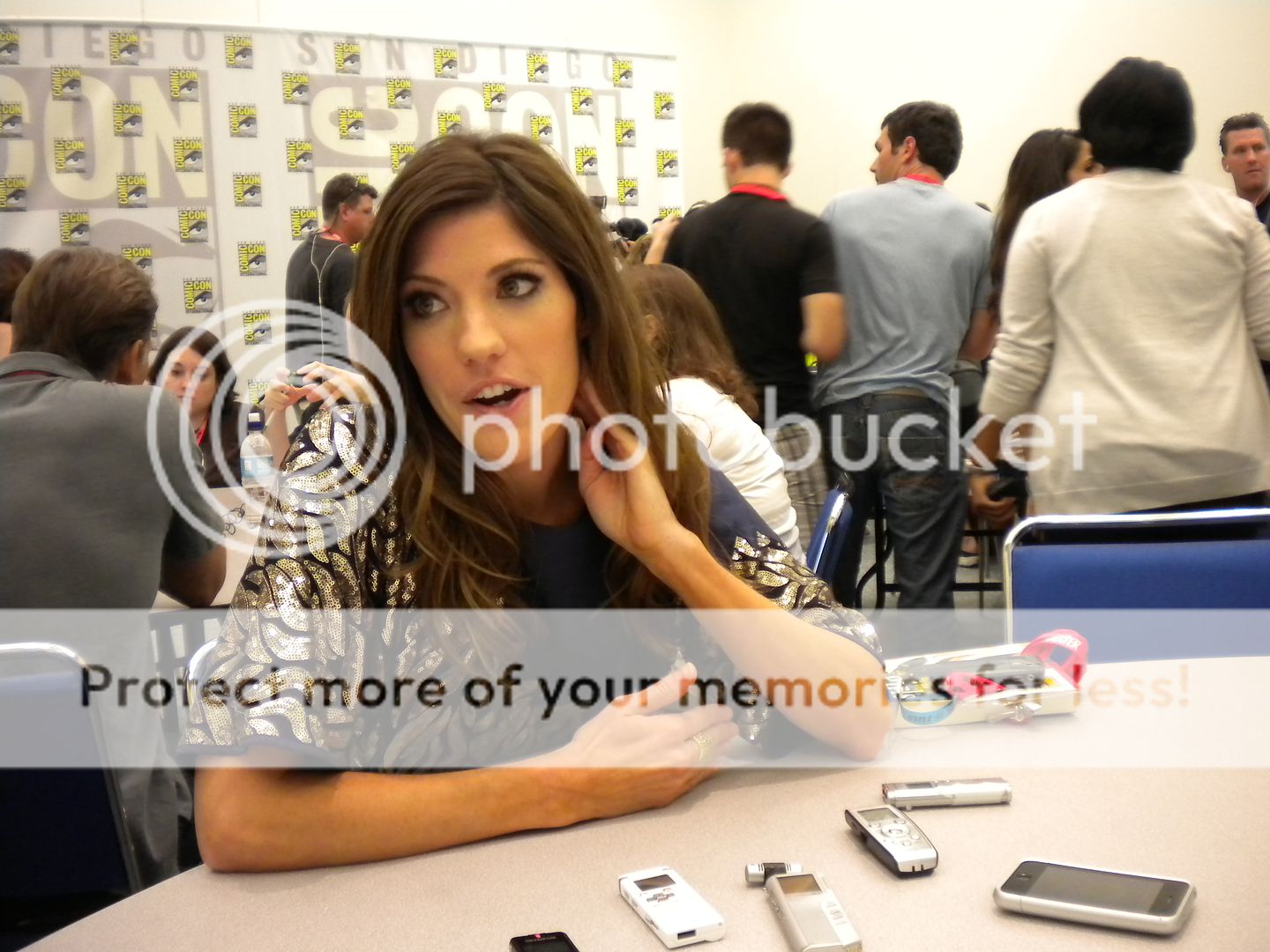
Jennifer Carpenter (Deb Morgan) was very excited about Season 5’s changes, though she admitted that for the first time, she really didn’t know what was going to happen. In the beginning of the season, Deb hopes that she and Dexter have a certain kinship, because they’ve both experienced loss, but that isn’t quite what happens. She correctly noted something I’ve noticed a lot about Deb, which is that she does a lot of talking at Dexter, and not with Dexter, which leads to his typical one-word answers. Jennifer noted that a lot of times, women in particular are guilty of “filling in the blanks” with the stories we want to hear (guilty as charged!), which affects Deb’s relationship with Dexter. She felt a little pressure of Comic-Con, with such a concentration of die-hard fans that you have to please, but pointed out that this is also the great thing about Dexter; they hate you one week and love you the next. Jennifer also hinted at growing suspicion on Deb’s part about Dexter, who experiences his grief a lot differently than her, but that the sister part of her refuses to piece it together. We asked Jennifer about the growing stripping away of Deb’s vulnerability, and how much more of that we’ll see in the upcoming season, and frankly, what she thought of it as character growth. Here’s what she had to say:
“I have to say that last year, Keith Carradine (Lundy), his line “You’re confused, and now you’re not. We’ll figure it out together.” was the first time on the show that I’ve heard someone say (to Deb) I’m going to help you. And then immediately he’s dead. That one line helped me play [the character] for seven episodes. I think about it now and I could cry my eyes out. This year, I feel like it’s about standing up straight, choosing your words, how you enter a room, she’s not editing herself, but she’s calculating. She’s working like a cop. And a little less of a potty mouth.” But not too much, she promised us!
Finally, we are thrilled to publish an interview that we have teased you about long enough. As we await the yearly MythBusters panel, always a hit here in San Diego, we had the opportunity to get some pre-Comic-Con scoop from one of our favorite MythBusters about her new hosting adventure on the Science Channel. Check it out:
Interview with MythBusters’s Kari Byron
ScriptPhD.com: Head Rush will primarily be aimed at kid-enthusiastic presentations of science. How did your interest in hosting and putting this show come together?
Kari Byron: This has been a passion project that Debbie Myers [general manager of The Science Channel], The Science Channel and I have been talking about for a while. There is a disconnect at about the age of 12 where girls stop being interested in science. And we just wanted to figure out a way to get them, and obviously all kids around that age, interested in science in a way that they could be passionate about it as well. We figured if we could create a show that was cool, not talking down to them, we could keep that interest alive.
SPhD: You have a very non-traditional science background as a sculptor and painter. How important is it to you to convey that a layperson can have a healthy curiosity and passion about science?
KB: Well I obviously came to science a little later in life, and I think that’s why I have the same excitement that you’d have when you were a kid for it. I think having no science background makes it more accessible in the way that you don’t have to be a scientist to enjoy the science.
SPhD: This programs is affiliated with President Obama’s STEM initiative. You and I chatted a bit about girl power at the Discovery Channel 25th Anniversary party. What kind of responses do you get from girls that are fans of your work on MythBusters?
KB: It’s really cool! I talk to a lot of moms and teachers as well, and I get excited [that they use], I hate to use the word role model because I feel like I don’t deserve it, but it’s nice that they have a really positive response. They like seeing someone that’s more like them.
SPhD: What small sneak peek can you give us to tease fans during Comic-Con to get them super excited about watching the show?
KB: I’m actually so interested in the material that we’re doing, that I’m just amazed at the stories. We do a bunch of experiments that give a hands-on approach to science. [Head Rush] is so different from MythBusters that I can’t even compare it. We will be using clips from all the Discovery brand shows, and a lot of MythBusters, of course, but the Head Rush segment of it is its own beast. I don’t know who or what I can reveal!
There you have it folks! Kari is so excited about her new show, she is hard pressed to reveal any secrets to spoil it. We thank her and Discovery Channel for granting ScriptPhD.com a sneak preview. Head Rush will air on The Science Channel beginning August 23, Monday-Friday 4-5 ET/PT, and Saturdays, 7-9 AM ET/PT.
Comic-Con 2010 Costume of the Day: ….and the unanimous winner is…. Calendar Man! We gave points for creativity.
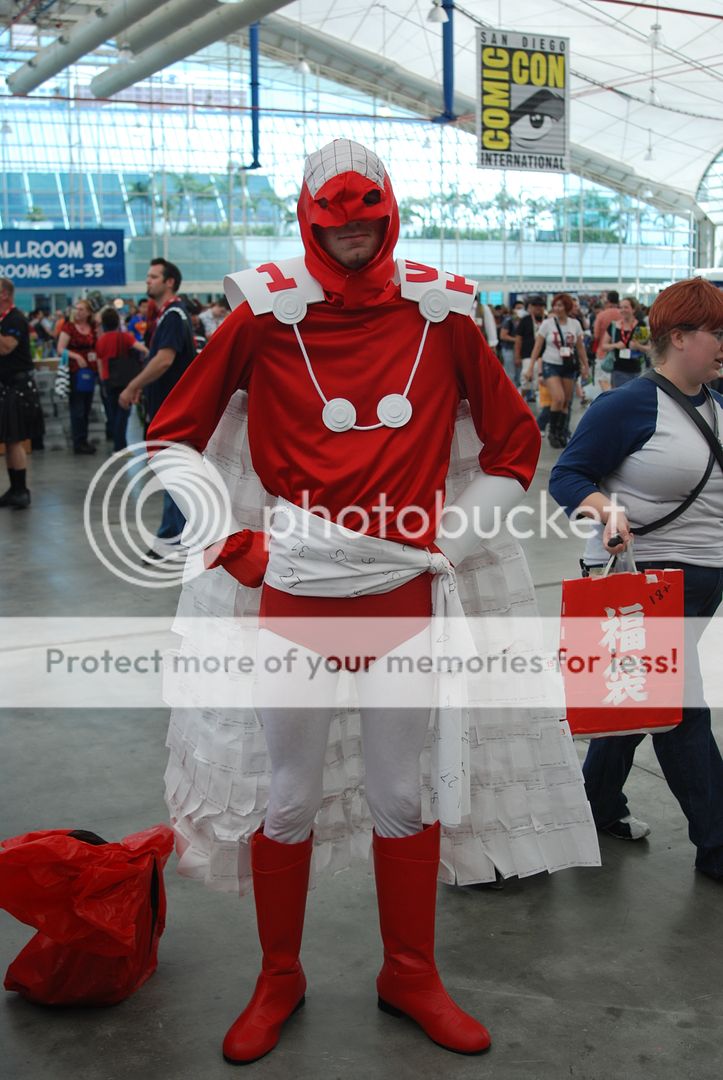

For a complete album of pictures from Comic-Con (and many of the costumes that didn’t quite make the running for Costume of the Day, take a look at our our Facebook fan page (and become a fan!).
~*ScriptPhD*~
*****************
ScriptPhD.com covers science and technology in entertainment, media and advertising. Hire our consulting company for creative content development.
Subscribe to free email notifications of new posts on our home page.
]]>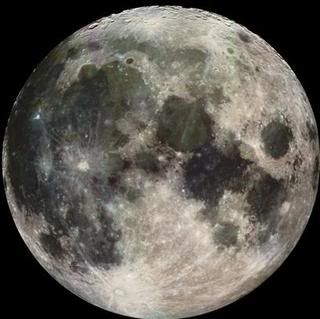
What is it with Hollywood releasing movies that coincide with NASA missions to outer space? Remember when Star Trek came out during the Hubble Telescope repair mission [read ScriptPhD coverage]? Moon, a thoughtful new science fiction indie feature from Liberty Films and Sony Pictures, featuring a near-solo bravura performance by Sam Rockwell, comes on the auspicious heels of NASA’s Lunar Reconnaisance Orbiter mission to remap and fortify our knowledge of Earth’s Moon and surrounding solar system that got off to a spectacular start on June 18th. ScriptPhD.com reviews Moon and discusses the LRO mission, along with some of the first days-old high-resolution topographical beamed moon images and their implications for further lunar missions. To read the article, click “continue reading”.
REVIEW: Moon
ScriptPhD Grade: B
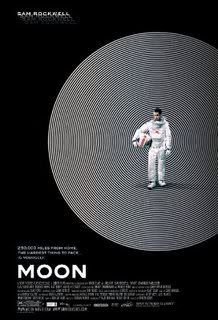
In the not-so-distant future, the Earth’s energy crisis is rendered obsolete. A megacorporation named Lunar Industries has found an innovative way to collect He3 from the Sun on lunar mining bases. Harvested much in the way we currently drill for oil, the energy is packed onto mini-rocket transporters, which are then fired back to Earth to provide for 70% of our planet’s energy needs. The mining station Sarang is manned by astronaut Sam Bell (Sam Rockwell) as part of a three-year solo mission. Sam leads a banal, isolated life on the station. Between Helium harvest runs in his Moon Jeep, he occupies his time with botany, builds miniature houses, performs calisthenics, and talks to himself. His only reminders from home are video messages from his wife, Tess and baby daughter Eve, and his sole companion on the moon is GERTIE, a Hal-esque robotic assistance machine (the surprising voice of Kevin Spacey). But Sam’s mission is a noble one. He is performing a duty to his country, and the only thing standing between Sam and his sanity is that his mission is two weeks from completion.
It soon becomes apparent that something about this mission is very, very askew. Sam’s brain appears to be deteriorating under the stress of the isolation he is experiencing—he sees visions of his wife and mysterious voices taunt him throughout the ship’s living quarters. During a drive to the lunar He3 harvesting station, a strange vision leads to an accident. He wakes up in a sterile makeshift hospital to GERTIE’s palliative reassurance, but something is wrong. Secret hushed conversations between GERTIE and base control and prevention of leaving the base or his hospital bed lead Sam back to the accident site only to discover that it was no accident at all. Trapped inside the truck is his very own body double! Forming an unlikely friendship in their quest for the truth, the two Sams discover a corporate conspiracy back on Earth—they are clones of the original Sam Bell. A secret room full of “Sam” clones rests below the module’s cryogenic transporter. Tess, Sam’s wife, is long dead, and his daughter a grown woman. Recycled memories are implanted into awakened clones as a mental training regimen. As one clone’s body atrophies graphically, coinciding with the appearance of mission control to reawaken another, the two avatars must make important choices to allow one freedom back on Earth.
Moon is, above all else, a space drama that explores several universal thematic questions. What is the value of a human life? The “Sam” modules have inherent feelings, memories (albeit implanted), desires and want for freedom. Additionally, what are the boundaries of loneliness and isolation that a human being, even a clone, can tolerate under extreme conditions? In an emotionally impactful moment during the film, Original Sam Clone reaches out to his avatar to shake his hand. “I’m lonely, man,” he says. “I’ve been here all alone for three years and I just want to shake your hand.” The storyline also weaves in a covert repudiation of corporate greed and hegemony, even for the sake of “doing good for mankind”. Lunar Industries explicitly conspires in the hijacking of a man’s life and participates in a cover-up to maximize profit from a beneficial technology. Is there ever a circumstance that warrants such moral opprobrium? The film argues there is not.
As a film, Moon encounters a number of problems in its attempt to unfold an ambitious plot. The core storyline is way too slow to develop. The Sam clone isn’t introduced until solidly into the second half of the movie, negating an opportunity to enhance that part of the plot. To that extent, the movie glosses over some pretty superficial treatment of both the relationships between the Sams, as well as that of Sam and his computerized caretaker GERTIE. The film’s ultimate denouement is made possible because of a conscious self-sacrifice by GERTIE, implicating that he loves Sam and wants to do what’s best for him, but the movie stops short of delving deeper into the potential bond of man and machine. The movie borrows heavily from 2001: A Space Odyssey, in theme and style, but feels recycled, and still leaves plenty of moral ambiguity in its resolution. Nevertheless, these shortcomings are mollified by some gorgeous lunar computer graphics imagery, a stellar emotional performance by Sam Rockwell, and ultimately works best as a powerful psychological thriller. You cannot help but be eerily moved at the claustrophobic isolation of the mining base, and panic at the thought of reliving the manipulation indefinitely.
Moon is currently in wide release.
Lunar Reconnaissance Orbiter (LRO) Mission and Lunar Crater Observation and Sensing Satellite (LCROSS) Probe Imaging
To help astronauts prepare for future long-term lunar expeditions, NASA is launching an exploratory precursor mission, the Lunar Reconnaissance Orbiter, to gather data on lunar environment. Using seven instruments that will be scattered along the Moon’s surface to collect data on radiation, test for resources and characterize the environment, the LRO will spend a year in low polar orbit beaming back never-before-seen pictures of lunar detail. The instruments include the critical LRO Camera, taking wide-angle black and white and ultraviolet images, the Miniature Radio Frequency, an advanced radar that will image polar regions and look for water and ice, the Lunar Orbiter Laser Altimeter, responsible for generating 3-D maps of the moon, the Lunar Exploration Neutron Detector, looking for neutron maps that will reveal water near the moon’s surface, the Lyman-Alpha Mapping Project, will search for surface ice and frost in the polar regions that might be hidden in permanently shadowed regions illuminated only by starlight and the glow of interplanetary hydrogen emission, the Diviner Lunar Radiometer Experiment, a device that will identify cold traps—areas cold enough to preserve ice for billions of years, and the Cosmic Ray Telescope for the Effects of Radiation, that will characterize the lunar radiation environment.
On July 8, the first series of LRO moon images were beamed back from the LRO camera, including the picture below of the Hahn crater (lower left), approximately 80 km in diameter.
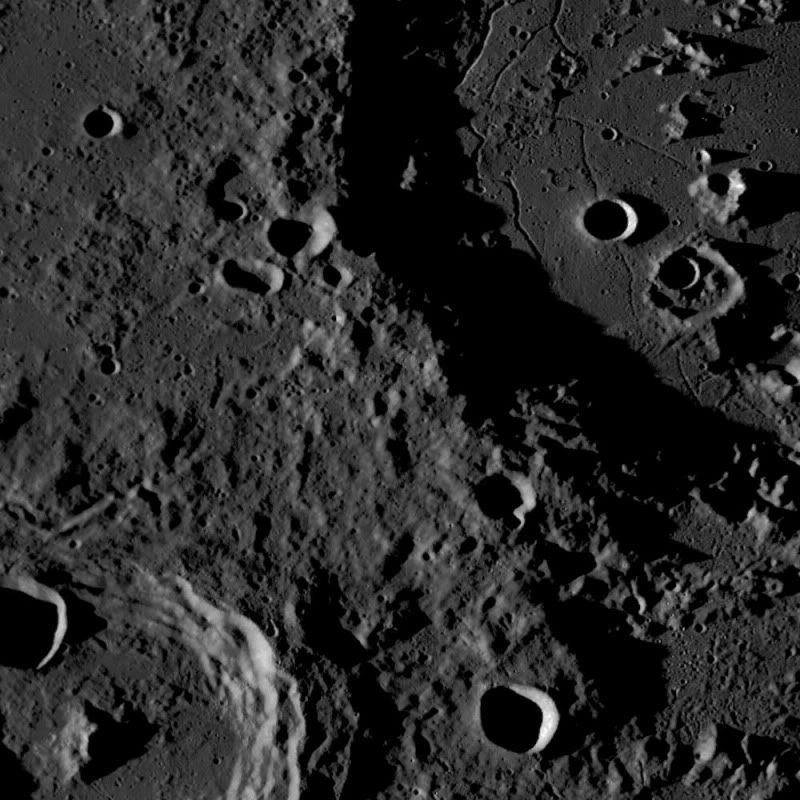
A second, critical, component of this mission is confirming the presence or absence of water ice in a permanently shadowed crater at the Moon’s South Pole, an objective that is going to be accomplished using the Lunar Crater Observation and Sensing Satellite (LCROSS), a co-manifested payload aboard the LRO. Any future human activities on the Moon, including the far-off possibility of habitation, rest on the presence of water. In October of 2009, LCROSS will excavate one of the South Pole’s craters with two impacts that will eject material from the impact into outer space, creating a plume of (theoretically) water, in the form of ice and vapor, hydrocarbons, and hydrated materials that will then be analyzed by the aforementioned LRO instruments. That’s right, NASA is literally going to crash into the moon! How cool is that?

Just a few days ago, work released by scientists at NASA’s Jet Propulsion Laboratory (JPL) in Pasadena, CA, in concert with the Goldstone Solar System Radar in California’s Mojave Desert, will considerably facilitate LCROSS impact estimations when it crashes into the Lunar South Pole on October 9th. From observations gathered by Goldstone’s massive antenna, and subsequently reflected signals back from the moon, a distance of 231,800 miles, scientists were able to construct a new topographical map over a region 311 by 249 miles on the Moon’s South Pole. JPL scientists created a false-color map over the topography contours, revealing craters and details within those craters that are otherwise permanently shadowed, and therefore invisible to humans. NASA scientists will utilize this new map to plan impact zones for the LCROSS probe and its Centaur rocket stage.
The Lunar Reconnaissance Orbiter, and Lunar Crater Observation and Sensing Satellite, lifted off together aboard an Atlas V rocket on Thursday, June 18. Watch the official NASA video of the LRO launch:
One Small Step for Man…
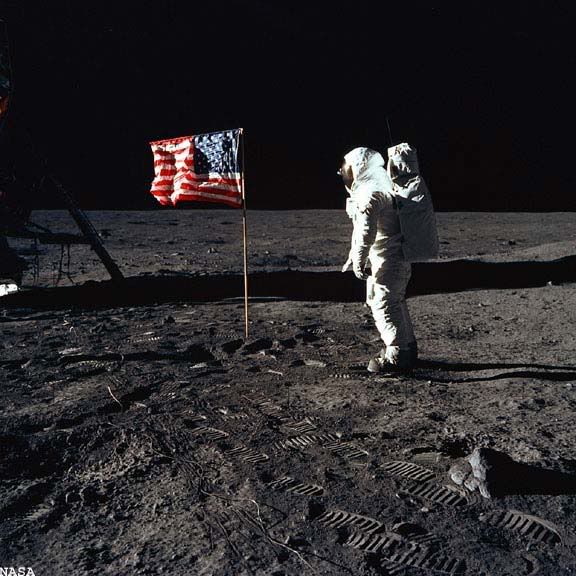
Today marks a momentous day in the history of space exploration: the 40th anniversary of the Apollo 11 mission to the moon. On this day, July 16, 1969, Apollo 11 launched into outer space at 9:32 AM Kennedy Space Center time, allowing Commander Neil Armstrong, Command Module Pilot Michael Collins and Lunar Module Pilot Edwin Eugene ‘Buzz’ Aldrin, Jr. to fulfill a challenge from President John F. Kennedy to reach the Moon by the end of the 1960s. On July 20, 1969, the lunar module Eagle separated from the command module Columbia (in which Collins orbited above during the moonwalk), and landed on the site named Tranquility Base, located in the Southwestern corner of the lunar plain Mare Tranquillitatis. In addition to their historic first walk on the Moon, Aldrin and Armstrong preserved soil samples (22 kg total of lunar surface materials), tested various properties of the surface, the Moon’s gravitational pull (approximately 1/6th of the Earth’s), and conducted various geological experiments.
Incidentally, as a part of the current LRO mission, the LRO camera will be using its moon-circling probe as an opportunity to hone in on several Apollo 11 sites, including the famous Eagle landing site and the astronauts’ footprints, assess the state of Tranquility Base, and the long-term effects of human artifacts in a lunar environment. This should no doubt put to rest the longstanding cries of conspiracy theorists and Apollo deniers who claim that the Moon landing was a manufactured hoax.
In honor of the 40th anniversary of the mission, NASA has employed the help of Hollywood digital remastering experts to restore footage of Neil Armstrong’s historic first steps on the moon, rendering the televised images clearer and in more detail than ever. The digital re-release comes with the sad news that NASA has permanently lost the original footage of the Apollo 11 moonwalk beamed back to Earth from the lunar camera aboard the Eagle. The original footage was more than likely inadvertently lost when NASA started recycling magnetic tapes from old missions during the early 1980s.
Watch the remastered footage:
Visit msnbc.com for Breaking News, World News, and News about the Economy
NASA will also be hosting a series of events during the week-long Apollo 11 celebration. Today kicked off the series with a NASA panel hosting astronauts Frank Borman, James Lovell and William Anders as they discussed their adventures in space, the Cold War, and the legacy of Apollo 11. Saturday night, the National Air and Space Museum in Washington, DC will dedicate its annual John H. Glenn lecture to the Apollo 11 mission, featuring a distinguished panel of astronauts, flight crew directors and politicians. On Monday, which will mark the 40th Anniversary of the original touchdown, all three of the original astronauts (among others) will gather for a live NASA headquarters briefing. You can listen to the entirety of the original NASA Apollo 11 audio transmissions, being replayed this week here.
ScriptPhD.com raises a glass to the occasion of this moment in history, to the men and women that made it possible, and to the new generation of scientists and astronauts shooting for the moon and rewriting our knowledge of the universe.
~*ScriptPhD*~
]]>
